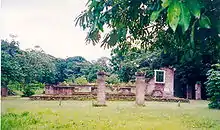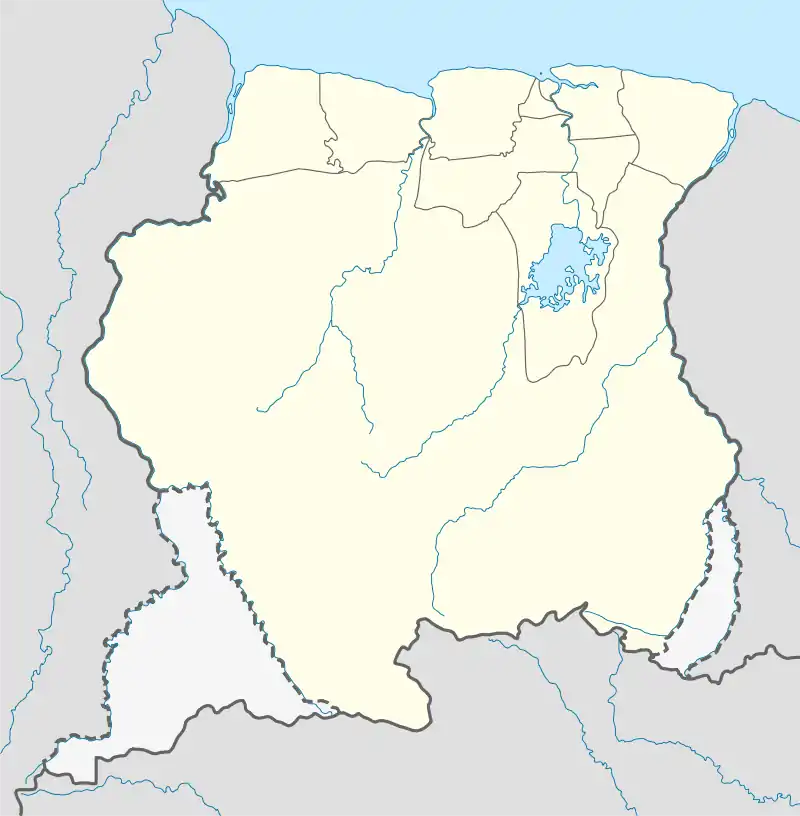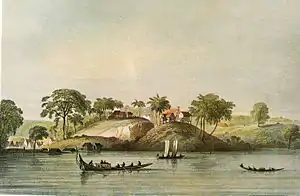Jodensavanne
Jodensavanne (Dutch, "Jewish Savanna") was an agricultural community in Suriname, South America established by Jews fleeing persecution in Spain. It was located in Para District, about 50 km (31 mi) south of the capital Paramaribo, on the Suriname River. Sugarcane plantations were established and Black African people were used as slave labour. The colony faced an attack and heavy levies imposed by a French captain, competition with sugar beets, disease and revolts from indigenous people and slaves. The community eventually relocated to the capital of Paramaribo. Clearing of grave-sites and maintenance of the synagogue ruins has taken place in the 21st century.
 The remains of the Beracha ve Shalom ("Blessings and Peace") synagogue on the Jodensavanne (February 2000) | |
 Shown within Suriname | |
| Location | Carolina, Para District, Suriname |
|---|---|
| Coordinates | 5°25′45.02″N 54°59′3.43″W |
| Type | Settlement |
History

In 1639, the English government allowed Sephardi Jews from the Netherlands, Portugal and Italy to settle the area. They came first to the old capital Torarica. On 8 April 1651, a petition was sent to the King of England by Benjamin de Caseras, Henry de Caseras, and Jacob Fraso for the permission to live and trade in the territories of Suriname and Barbados, marking a solid date for the origins of a Jewish community being established within the territory. In the year 1652, a new group of approximately twelve hundred that migrated under the leadership of Lord Willoughby (Francis Willoughby, 5th Baron Willoughby of Parham) settled in the area now known as Jodensavanne. A third group came 1664, after their expulsion from Brazil and then French Guiana, led by David Cohen Nassy. In 1670, according to the Essai Historique, approximately two hundred or so Jewish people had left Suriname, and in 1677, a year before the Carib assault on Jodensavanne, ten Jewish families had left with their slaves.
The Jewish community was granted some autonomy[1] and developed a sugar-cane plantation economy. European settlements including those in the Jodensavanne were attacked by Carib (Kalina people) in the latter part of 1678 and slaves also revolted.[2]
The congregation Beracha ve Shalom ("Blessings and Peace") was founded, with the first wooden synagogue in the community (the 3rd synagogue in South America) built between 1665 and 1671 and a second, made of imported brick, was constructed in 1685. Before the construction of the Beracha ve Shalom, there had been no synagogue of major architectural significance in the Americas.[3] The centennial celebration of the Synagogue, celebrated in October, was said to have an attendance of more than 1500 persons.
Jodensavanne declined during the mid-18th century, and most of its population moved to Paramaribo. The population was approximated to be around twenty-two, excluding slaves, in 1790, and dropped to less than ten by the early 19th century.[4] The colony continued to survive until it was destroyed in 1832 by a slave revolt and the resulting fire.
Historian Natalie Zemon Davis is working on a history of 18th century Jodensavanne, focusing on David Isaac Cohen Nassy (born 1747) and relations between blacks and whites in the Jewish community.[5] An article titled 'Regaining Jerusalem' was published in 2016 by Davis, detailing a celebration of Passover within Jodensavanne.[6]
_(23831044676).jpg.webp)
Internment camp
During World War 2 Jodensavanne had been used as an internment camp. In 1942 Camp Jodensavanne was constructed to house 146 people from Indonesia who were either members of the Dutch NSB or the German NSDAP.[7] The group was arrested before the Japanese invasion of Indonesia, and transported to Suriname without trial on the allegation of membership. Eight people died in the camp of which two were shot while trying to escape.[8] After the liberation of the Netherlands on 5 May 1945, they were forgotten, and finally released on 15 July 1946.[7] In 1949–50, an investigation was launched into the two escapees, however the case was dismissed. It was not until 1994 when Minister Joris Voorhoeve apologized to the family of the deceased.[9]
Current situation
As of the current day, all that remains at the site of Jodensavanne are the remnants of the Berache ve Shalom Synagogue, alongside three cemeteries, of which the headstones are primarily inscribed with Hebrew and Portuguese.[3]
The Archaeological Institute of the Americas, in partnership with the University of Suriname, engaged in a project labeled as the 'Interactive Dig Jodensavanne', of which conservation efforts and record-keeping projects have been active since 2014.[10]
The Jodensavanne is located near the indigenous village of Redi Doti,[11] in the Carolina resort, and connected to the outside world with the Carolinabrug which leads to the Afobakaweg onto Paramaribo or via the Desiré Delano Bouterse Highway to the airport.[12]
Population
The population at Jodensavanne has been approximated in two ideals. Foremost, as held by sources such as the Essai Historique,[13] would assert the population to be held at approximately one thousand in 1677; in contrast, historians such as Harry Friedenwald have published on the lack of strong Jewish presence on the island, an assertion that would imply a less populated Jodensavanne than most assertions.

There were around 70 existing plantations along the Suriname River in 1750, most of which bearing 'Jewish' names, such as the thousand acre properties owned by one Solomon Meza.[4] These plantations were marked and identified through an 18th-century map titled, "Algemeene Kaart van de Colonie of Provintie van Surinam", drawn by engineer Alexander de Lavaux, a Berlin native who served in Prussian forces.
There were several cemeteries located within Jodensavanne, of which the most heavily used, and first existing cemetery is known as the Cassipora Cemetery. Named in due part to the Cassipora Creek that stems from the Surinam river, it is expected to hold approximately two hundred tombstones, the earliest of which being from the early 17th century, and the most recent believed to have been constructed in 1840. The headstones here are primarily inscribed with Hebrew, Portuguese, and Dutch, and there exist several ohelim in the area as well, an indication of the Jewish community structures within the settlement.[3]
See also
References
- This Day in Jewish History by David B. Green 17 Aug 2014 Haaretz
- Jonathan D. Hill (1996). History, Power, and Identity: Ethnogenesis in the Americas, 1492-1992. University of Iowa Press. p. 32. ISBN 978-1-58729-110-4.
- Frankel, Rachel (2001), "Antecedents and Remnants of Jodensavanne", The Jews and the Expansion of Europe to the West, 1450-1800, Berghahn Books, pp. 394–436, doi:10.2307/j.ctt1x76f5z.26, ISBN 9781782389767
- 1862-1936., Gottheil, Richard James Horatio (1901). Contributions to the history of the Jews in Surinam. American Jewish Historical Society. OCLC 847522377.CS1 maint: numeric names: authors list (link)
- Herschthal, Eric (17 August 2006). "A Star Historian Opens a New Chapter: Jewish Slaveowners". The Jewish Daily Forward. Retrieved 12 August 2020.
- Davis, Natalie Zemon (11 December 2015). "Regaining Jerusalem: Eschatology and Slavery in Jewish Colonization in Seventeeth-Century Suriname". The Cambridge Journal of Postcolonial Literary Inquiry. 3 (1): 11–38. doi:10.1017/pli.2015.29. ISSN 2052-2614.
- "Kamp Jodensavanne zwarte bladzijde". Straf Kolonie (in Dutch). Retrieved 18 May 2020.
- "Strafkolonie Jodensavanne". Werkgroup Caraïbische Letteren (in Dutch). Retrieved 18 May 2020.
- "Indische NSB'ers in concentratiekamp Jodensavanne". Prinses Irenebrigade (in Dutch). Retrieved 18 May 2020.
- "A Brief History of Jodensavanne, Suriname - Archaeological Institute of America". www.archaeological.org. Retrieved 20 November 2018.
- "Education Redi Doti". Jodensavanne.sr. Retrieved 18 May 2020.
- "De Afobakaweg". Vakantie Arena (in Dutch). Retrieved 18 May 2020.
- -1995., Rens, L.L.E. (Lucien Leo Eduard) (1954). Analysis of annals, relating to early Jewish settlement in Surinam. OCLC 773200985.CS1 maint: numeric names: authors list (link)
Further reading
- Remnant Stones. The Jewish Cemeteries of Suriname Ben-Ur, Aviva en Rachel Frankel Epitaphs, 2009 (Hebrew Union College Press)
- De groene hel. Een Nederlands concentratiekamp in Suriname A.G. Besier March 1, 1942 to July 15, 1946, Bunne 1994 (Uitg. Servo)
- De strafkolonie. Een Nederlands concentratiekamp in Suriname 1942 - 1946 Twan van den Brand Amsterdam 2006 (Uitg. Balans)
- Wreedheden in Kamp Jodensavanne. De groene hel Maaike Verschuren, Parbode, nr. 33, januari 2009, pp. 46–48.
External links
| Wikimedia Commons has media related to Jodensavanne. |
- Jodensavanne Foundation
- Jews in Suriname
- The settlement of Joden Savanne and Cassipora cemetery at UNESCO.org
- Penal colony at Jodensavanne(in Dutch) at strafkolonie.nl